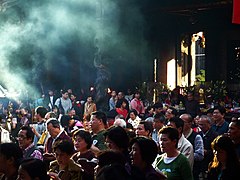Bangka Lungshan Temple
| Bangka Lungshan Temple | |
|---|---|
| Native name 艋舺龍山寺 (Chinese) | |
| Lungshan Temple of Manka; Mengjia Longshan Temple | |
 view of the outer courtyard of Lungshan Temple in 2023 | |
| Location | Wanhua, Taipei, Taiwan |
| Built | 1738[1] |
| Built for | Chinese folk religion; Chinese Buddhist, Taoist, and Confucian deities, including Guanyin, Mazu, and Guan Yu.[1] |
| Rebuilt | 1919–1924[1] |
| Website | www |
| Bangka Lungshan Temple | |||||||||||
|---|---|---|---|---|---|---|---|---|---|---|---|
| Traditional Chinese | 艋舺龍山寺 | ||||||||||
| Simplified Chinese | 艋舺龙山寺 | ||||||||||
| |||||||||||
Bangka Lungshan Temple[1][2][3][4][5][6] (also Lungshan Temple of Manka, Mengjia Longshan Temple) is a Chinese folk religious temple in Wanhua District (alternately known as Bangka/Mengjia), Taipei, Taiwan. The temple was built in Taipei in 1738 by settlers from Fujian during Qing rule in honor of Guanyin. It served as a place of worship and a gathering place for the Chinese settlers. In addition to its Chinese Buddhist elements, it includes halls and altars to Chinese folk deities such as Mazu and Guan Yu.
History
[edit]This temple originated its name from the ancient Lungshan Temple established in Chin-chiang county of Fukien province in the seventh century. Immigrants from the three counties Chin-chiang, Nan-an and Hui-an of Fukien came to Manka in the beginning of the eighteenth century. As they were pious followers of that ancient Lungshan Temple in their home town, they erected this one as a branch temple at Manka and named it after the root temple when they created a new settlement here in Taipei. Lungshan Temple of today is no longer in the original buildings constructed in 1738. It was rebuilt in 1919 and completed in 1924.[1]
The temple has been destroyed either in full or in part in numerous earthquakes and fires but Taipei residents have consistently rebuilt and renovated it. The temple was rebuilt during Japanese rule. Most recently, it was hit by American bombers during the Taihoku Air Raid on May 31, 1945, during World War II because the Japanese were reportedly hiding armaments there. The main building and the left corridor were damaged and many precious artifacts and artworks were lost.[1] It was rebuilt after the end of World War II a few months later.
Gallery of images
[edit]-
view of the inner courtyard of Lungshan Temple
-
Longshan Temple at night
-
view of the inner courtyard of Lungshan Temple in 2023
-
Longshan Temple′s interior.
-
Statue of Guanyin at Lungshan Temple.
-
Worshipers during Chinese New Year.
-
Chinese Dragon on Lungshan Temple.
Transportation
[edit]The temple is accessible within walking distance North from Longshan Temple Station of the Taipei Metro.
See also
[edit]- Bangka Park
- Bangka Qingshui Temple, Wanhua District
- Dalongdong Baoan Temple, Datong District
- Xingtian Temple, Zhongshan District
- Ciyou Temple, Songshan District
- Guandu Temple, Beitou District
- Lukang Longshan Temple, Changhua County
- Fengshan Longshan Temple, Kaohsiung
- List of temples in Taiwan
References
[edit]- ^ a b c d e f "THE INTRODUCTION OF LUNGSHAN TEMPLE". 艋舺龍山寺網站. Lungshan Temple. Retrieved 10 June 2015.
- ^ 艋舺龍山寺季刊 [Bangka Lungshan Temple] (44 ed.). April 2019.
- ^ Scott Morgan (11 November 2018). "Taiwan's list of national monuments to reach 100 after addition of 2 temples: report". Taiwan News. Retrieved 30 September 2019.
Dalongdong Baoan Temple and Lungshan Temple of Manka expected to be added to list of Taiwan's national monuments
- ^ Sejal Mehta (15 September 2019). "The many surprises of Taipei and Taichung". livemint. Retrieved 30 September 2019.
Since it was built in 1738, Taipei's Lungshan Temple has been brought down many times by earthquakes, and even a World War II bombing.
- ^ "ASA Taiwan". The Hallmark. United States Army Security Agency: 9. May 1970 – via Internet Archive.
The Lungshan Temple, a Buddhist edifice in Taipei, is known for its ornate roof decorations and wood carvings.
- ^ O. Donald Meaders (April 1985). "Development and Strengthening of Agricultural Education in St. Lucia. A Report". p. 33 – via Internet Archive.
Field trips to botanical garden, National Palace Museum, Lungshan temple, Chiang kai-Shek [sic] Memorial Hall and Sun Yat-Sen Memorial Hall.
External links
[edit]- The Lungshan Temple website
 Geographic data related to Bangka Lungshan Temple at OpenStreetMap
Geographic data related to Bangka Lungshan Temple at OpenStreetMap- Longshan Monastery, Architectura Sinica Site Archive








